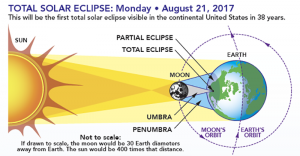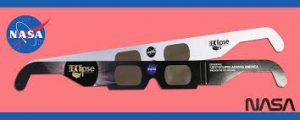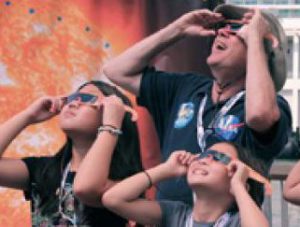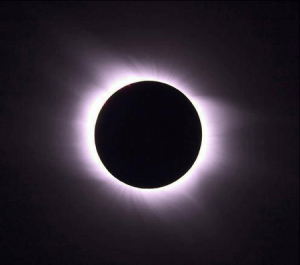This post was originally published on August 19, 2017
The latest update to this post was made 5 years ago.
 Solar Eclipse 2017
Solar Eclipse 2017
Monday, August 21, 2017, North America will witness a solar eclipse. The path of totality will cross parts of Oregon, Idaho, Montana, Wyoming, Nebraska, Kansas, Iowa, Missouri, Illinois, Kentucky, Tennessee, Georgia, North Carolina and South Carolina. Other parts of the United States will see a portion of the eclipse that will also be a sight to remember. If you miss this eclipse, there will be another one in seven years.
What is an eclipse?
There are solar and lunar eclipses that occur due to the alignments of the sun, Earth and moon. In the solar eclipse the Moon moves right to left in its orbit around the Earth. The shadow from the Moon moving between the Sun and Earth will cast a shadow on the Earth.

This shadow is what will cross the United States on August 21, 2017. NASA posted an eclipse topic on their Houston, We Have a Podcast. The host is great with the scientist, Mark Matney. The stories and explanations are worth a listen!
Steve Spangler explains in the video below what an eclipse is and it is great for younger people.
My Experience
I was able to witness a solar eclipse in 1970 and 1979. In 1970, I was young but I can remember my father taking a piece of cardboard and poking a hole through it and holding it over a piece of paper taped to the sidewalk. We all watched the white dot on the paper get slowly covered up by a shadow. I remember being able to look up quickly when it was covered, but then we all looked back at the paper really fast. We knew then not to look at the Sun, plus my father was there to let us know when to stop looking. In 1961, Richard Fleischer filmed Barabbas. A real eclipse took place during a crucial scene. The actors had one take and one chance of getting their parts right. The scene is powerful especially when you realize that a real eclipse is taking place.
Safety
Safety on watching the eclipse has been in the news and all over social media. The main key safety fact is not to look at the Sun. This baffles me that we have to remind people not to look at the Sun. It is sad that some think an eclipse changes the Sun. Please remember the Sun does not change and looking directly at the Sun can and will damage your eyes.
Tips
There are safety tips all over the web and on the news. The NASA Eclipse site has viewing tips that are great. Tip number one is to never look directly at the Sun without proper eye protection.

Eclipse glasses have special solar filters that make it safe to look at the Sun during an eclipse. The eclipse glasses can be worn on top of normally worn eyeglasses. These eclipse glasses should be rated ISO 12312-2. Everyone should test eclipse glasses before use. If there are scratches on the glasses, do not use them. To test the glasses:
- Stand in front of a car with headlights on at night.
- Put the glasses on and look at the headlights.
- If you see a bright light or can clearly see the headlights, then do not use the glasses.
- If you see a slight soft glow or nothing at all, they are safe.

Children should be supervised at all times. Even if you are using a pinhole method or eclipse glasses, children should be supervised to make sure they are using their method properly. Activities for children can be found in the NASA Eclipse Kit.
Sunglasses are NOT the same as eclipse glasses. Do not look through a camera, binoculars, telescope while using the eclipse glasses. Cameras and telescopes should have special solar filters on them before you use them. Do not try to use the eclipse glasses as a filter for these devices.
Other Ways to View
Viewing the eclipse can be fun without using eclipse glasses. A pinhole viewer can be made to view the eclipse.
The sunlight will cast a bright dot on your paper and then watch the shadow move across the circle. Boxes can be used to make these viewers.
Using simple household items such as colander can be used to view the eclipse. The main rule is to never look directly at the Sun!
People Need To Be Educated
People are also scared of the Sun’s radiation during an eclipse. This just shows how stupid some people are. The radiation does not change during an eclipse. It is safe to go outside during an eclipse. Steve Spangler addresses many of the silly questions and comments he has received regarding the eclipse. Some are funny and some are just downright sad. The video is sad because people actually were serious. What have we become?
Schools are divided on the viewing of the eclipse. Part of this is liability. They do not want to be responsible for a child looking directly at the Sun and getting eye damage. Parents will sue. Many schools have mandated that no classes will view the eclipse. There are live streaming channels of the eclipse, but it is not the same as viewing it first hand.
Schools that are not allowing students to view the eclipse might have students absent due to parents keeping them home to view the eclipse. Parents need to educate their children on safety of viewing the eclipse regardless of children are viewing the eclipse at school or with the parents.

Stepping off the soapbox for now. The eclipse is an experience. Everyone should be able to view the eclipse and view it safely. Remember the simple basic rule of not looking directly at the Sun and you will have a memorable experience. Information on the eclipse and viewing the eclipse is all over the news and web. Make sure you use a reliable source in making decisions. The NASA Eclipse site is a good source of reliable information.
Timing
The full eclipse is expected to last between 2 minutes and 2 minutes 40 seconds.
- Depoe Bay, OR 10:17am PST
- Salem, OR 10:18am PST
- Madras, OR 10:19am PST
- Idaho Falls, ID 11:33am MST
- Grand Teton, WY 11:36am MST
- Casper, WY 11:43am MST
- N. Plattle, NE 12:55pm CST
- Lincoln, NE 1:02pm CST
- Sabetha, KS 1:05pm CST
- Columbia, MO 1:13pm CST
- Jefferson City, MO 1:14pm CST
- Carbondale, IL 1:21pm CST
- Paducah, KY 1:22pm CST
- Hopkinsville, KY 1:25pm CST
- Nashville, TN 1:27pm CST
- Clayton, GA 2:35pm EST
- Clingman’s Dome, NC 2:36pm EST
- Talulah Falls, GA 2:37pm EST
- Greenville, SC 2:39pm EST
- Columbia, SC 2:41pm EST
- Charleston, SC 2:47pm EST
Tags: #eclipse2017, #eclipse, #solareclipse, #education, #space, #totalsolareclipse
![]()

Be the first to comment